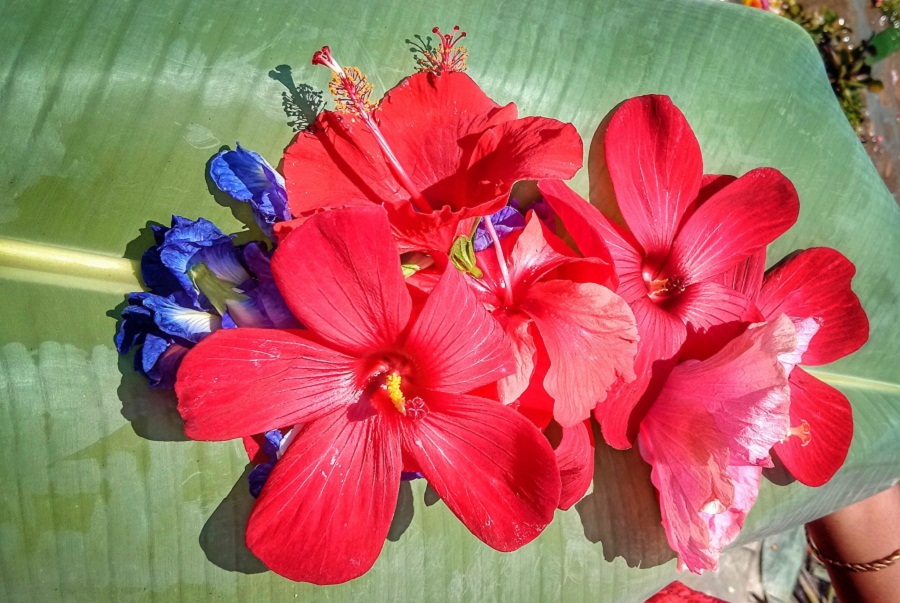New Year in the Hill Tracts: Where identity finds expression through celebration

Published :
Updated :

Red, purple, and yellow flowers bid goodbye to the last of spring. Jum lands in early preparation for cultivation, the sun pouring out onto the lush greenery, and the air hums with festivity as the hill tracts of Bangladesh celebrate the arrival of the New Year.
Bangladesh, home to over 54 ethnic groups of people speaking at least 35 languages, witnesses this celebration during mid-April, towards the end of the Bengali month Chaitra and the beginning of the Bengali month Baishakh.
The hill tracts bid farewell to the old year and welcome the new year through vibrant celebrations of Biju by the Chakma community, Sangrai by the Marma community, Baishu by the Tripura community, Bishu by the Tangchagya community, Changkran by the Mro community, Sangkran by the Khumi community, Bihu by the Ahamiya community, and Sangraing by the Chak community.
All the festivals are commonly referred to with the umbrella term Boishabi, combining the first syllables of Biju, Sangrai, and Baishu. They are celebrated by the three largest ethnic groups of the hill tracts: the Chakma, the Marma, and the Tripura.
The Chakma community celebrates the Biju festival from April 12 to April 14. The first day of the celebration is known as Ful Biju. The Chakma people collect flowers from midnight to dawn, and just after sunrise, they release beautifully arranged flowers on a banana leaf into a water body as a worshipful offering, signifying letting go of the old sorrows and hoping for blessings for the coming year.
Flowers are offered in worship to Lord Buddha. Elders and close ones are presented with flowers, and their homes are decorated with them. On Mul Biju, the 2nd day of the festival, their traditional dish, Pachon, is prepared.
Men, women, and children wear beautiful dresses and spend the day with much festivity. After the evening, they light Pradips, hoping for goodness in the next year.
The first day of the new year and the last day of the festival, Gojjapojja Bijhu, are spent resting during the day. After the evening, they worship the Lord Buddha in temples and listen to religious preachings.
The Marma community celebrates the Sangrai festival on April 14, the beginning of the new year. The elderly observe the Ashtashil ritual. After showering the Buddhist statue with Chandan water, they showered and wore new clothes.
The day is spent visiting each other's home, singing, dancing, and eating good food. One of the main attractions of the Sangrai festival is Rilongpoye or Jal Keli, springing each other with water in a cheerful setting.
The Tripura community celebrates the Baishu festival from April 13 to April 15, with the first day known as Hari Baishu.
Waking up early at dawn, they bathe in sacred water bodies to purify themselves of all past sins and offer flowers in worship to water. Garia dance is a traditional dance form that began to be performed by Hari Baishu.
They engage in fun games and competitions. On the 2nd day, known as Bisuma Baishu, everyone visits each other. Their traditional dish, Pachon, is prepared by combining a plethora of vegetables.
On Bisuma Baishu, only food prepared with vegetables is taken. Delicious Pitha of various kinds are prepared. The Tripura community celebrates the beginning of the new year on April 15, known as Atadang Baishu.
After offering prayers (Puja), they pay respect to their elders by Pronam and present flowers at the feet of the elderly. The elders give the youngsters Pronami (money as gifts), multiplying their cheerfulness.
On Atadang Baishu, the house door is kept open all day as a sign of welcomeness to everyone. No guest is returned unattended.
In addition to the Tangchangya, the Khumi, the Chak, the Ahamiya, the Mro, the Chakma, the Marma, and the Tripura, each ethnic community of the hill tracts adds its flavor to the celebration. Each festival has its own beliefs, spiritual significance, rituals, and traditions distinct from one another. The intricate beauties of all the festivals blend to create the splendid mix of joy and festivity that surrounds the hill tracts.
Though mainly celebrated at the hill tracts, celebrations are also done with proper respect and merriment on a small to large scale nationwide.
Each festival offers a deep insight into the lives, beliefs, and values of the people themselves, embodying the identity, enriched culture, and distinctness of the communities while fostering fraternity and unity at the same time.
"To truly know one - another, we must know about our history and where we are coming from. The New Year's celebrations provide us with an avenue for looking into the other's life, getting to know one another, intermingling, and cultural exchange. We should learn about each other and accept the beauty and good in each other. It is knowledge and communication that prevents misunderstandings", says Priti Bala Tripura, a professional teacher in an educational institution, referring to the celebrations on the eve of New Year in Bangladesh.
As with the ever-evolving nature of human societies, the New Year celebration of ethnic minorities is going through rapid changes, owing mainly to cultural exchange and inevitable lifestyle changes. But what remains constant over time is the innate intimacy with nature and life, ever joyous and lively.
afieaibnatsuchi@gmail.com


 For all latest news, follow The Financial Express Google News channel.
For all latest news, follow The Financial Express Google News channel.